Luminous Essence – Floater Structures in the Ancient Mesoamerican Art
abracad, · Categories: entoptic phenomena, externally authoredBy Floco Tausin
Eye floaters – vitreous opacities or consciousness light? A glimpse into the art and myths of former and non-Western cultures suggests that floaters had a spiritual meaning for many people. This article presents floater motifs and their meaning in pre-Columbian Mesoamerican cultures.
This article is based on the experience that a certain type of eye floaters – the “shining structure floaters†– are not “vitreous opacities,†as ophthalmology claims. Instead, they are a phenomenon of our consciousness. This insight is the result of my time of learning with Nestor, an Emmental seer (Tausin 2011, 2010a, 2009).
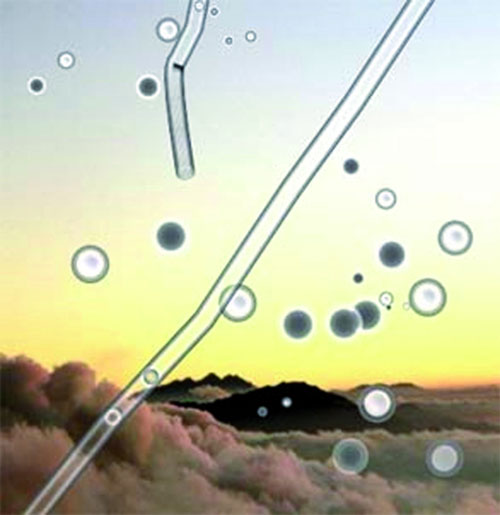
Fig. 1: Shining structure floaters (Muscae volitantes). Source: FT.
In my further research, I found numerous indications that floaters – along with other entoptic, i.e. “generated within the visual system,†phenomena – were perceived, artistically reproduced and passed down by the people of many cultures, ancient and modern (e.g. Tausin 2015, 2012c, 2012d, 2010b). They were probably seen and mythically or spiritually interpreted in the wake of consciousness altering practices (Tausin 2012b). This article supports this assumption by presenting floater structures in some of the native cultures of pre-Columbian Mesoamerica, especially the Olmecs, the Maya and the Aztecs.
Pre-Columbian civilizations in Mesoamerica
Mesoamerica is a coherent cultural complex in Central America, including Central Mexico, Guatemala, Belize, El Salvador, Honduras, Nicaragua and northern Costa Rica. From c. 1500 BC until the arrival of the Spanish in the 16th century, several Amerindian civilizations developed in these areas. The culture of the Olmecs, or the “rubber people,†originated very early in the lowlands of the Mexican Gulf Coast. The Olmecs are known for their elaborate stone monuments, such as the Colossal Heads, for founding major cities and for trading in exotic resources throughout Mesoamerica. Many achievements of later Mesoamerican civilizations were already anticipated by the Olmecs, including the pyramids, the ball game, and a writing system. When the Olmec civilization collapsed around 400 BC, a number of cities of the western heartland continued many of the traditions. The resulting “Epi-Olmec†culture is known for further progress and innovations in the fields of calendar and writing (Léon-Portilla 2005; Urcid 2005; Killion/Urcid 2001). The most ingenious and innovative heirs of the Olmec culture were the Maya, who already settled around 2500 BC in Guatemala. In the later Pre-Classic period (c. 400 BC to 100 AD), the Maya homeland extended from the Mexican Yucatán Peninsula, the rain forest of northern Guatemala, to the highlands of western Salvador. During the cultural blossoming of the Classic period (c. 200 to 900 AD), the Maya perfected their skills in the fields of agriculture, arts and crafts, writing, calendar, monumental architecture, as well as social and political organization. Towards the end of the 9th century, the production of art works ceased and many Mayan cities were abandoned: The Classic Maya civilization has collapsed, probably due to rivalries and invasions, but also the due to ecological disasters (Beukers 2013; Medina-Elizalde/Rohling 2012; Léon-Portilla 2005; Riese 2000; Krusche 1965).

Fig. 2: The cultural areas of the Mesoamerican civilizations of the Olmecs, the Maya and the Aztec. Source: matrix.msu.edu (30.4.15).
Further north, in Central Mexico, a major regional power arose in the first centuries AD: Teotihuacán. While first traces of settlements reach back to 1500 BC, the city-state became the dominant center in the Valley of Mexico in the first centuries AD, in particular due to the exploitation of, and long-distance trade in, obsidian. Between 400 and 600 AD, Teotihuacán was at the peak of its power and influenced or dominated large parts of Mesoamerica. Shortly after, the city-state was in decline for unknown reasons, the population decrease led to the collapse in 759. The power vacuum left by Teotihuacán in the 8th and by the Maya in the 10th century was filled by cultures from Central Mexico. One of the impulses came from the city of Tollan (Tula). However, it is controversial whether the “inhabitants of Tollan,†the Toltecs, actually developed a distinct culture, or whether this is a myth of the later Aztecs who viewed the Toltecs as skilled artisans and as their predecessors. The Aztecs who called themselves “Mexica†and claimed heritage from the mythic place “Aztlan,†were one of several Nahuatl-speaking groups from the north who settled in Central Mexico in the late 13th century. They founded their capital Tenochtitlan on islets in Lake Texcoco and joined forces with the city-states of Texcoco and Tlacopán. When the Spanish arrived in the early 16th century, this “Aztec Triple Alliance†ruled over much of Mexico and its people of various ethnicities and languages (Léon-Portilla 2005; Prem 1999).
Floater structures in Mesoamerican art
The testimonies of the Mesoamericans include numerous representations of deities, humans, animals, glyphs and symbols on sculptures, murals, reliefs and in books. Among these are many geometric forms and patterns that indicate entoptic phenomena. In particular, the dotted or concentric circles that accompany gods or other characters can be considered as floaters. However, the form alone is not sufficient to identify shining structure floaters in Mesoamerican art. For the object of art has always been what appears meaningful enough for a culture or individual artists to record and remember. Floaters, however, are an everyday phenomenon that doesn’t ensure survival or enrich life and, therefore, hardly has any significance. It is only in intense states of consciousness that floaters appear so close, big, luminous, and ordered that the seer understands them as cosmic, mythic or consciousness phenomena (Tausin 2010a, 2009). The question is, then, whether Mesoamerican art has developed in an environment, in which changes of consciousness states were regarded as an important source of knowledge. Indeed, researchers like Weston La Barre, Erika Bourguignon, Richard Evans Schultes, R. Gordon Wasson, Albert Hofmann, Marlene Dobkin de Rios, Gerardo Reichel-Dolmatoff and others have pointed out that the art of past and present indigenous Meso and South Americans can be understood as an expression of subjective visual experiences during altered states of consciousness (see Tausin 2012b; Harvey/Wallis 2007; Thurston 1997). These altered states are experienced in the context of shamanic rituals such as fasting, dancing, sleep deprivation or bloodletting (Gronemeyer 2003). Often, these rituals were performed under the influence of hallucinogenic substances, which are known to intensify entoptic phenomena. For ritual, divinatory and medical purposes, the pre-Columbian civilizations used Peyote, mushrooms of various genera, hallucinogenic glandular secretions of Bufo toads, various datura and tobacco plants, and the seeds of several species of morning glory, among others. Using such substances, the shamans are able to leave their bodies and fly to the Otherworld, transform into maize, rain or animals, find lost souls, fight dangerous spirits, lead the deceased to the underworld or ask spirit helpers or gods for knowledge and advice about plants, diseases or events (Carod-Artal 2015; Rätsch 2004; Furst 2005; cp. Gerritse 2013; Riese 2000). Accordingly, many clues about hallucinogenic plants can be found in Mesoamerican representations. For example, the cosmic tree on the mural of Tepantitla in Teotihuacán (fig. 13) could be a morning glory (Furst 1972), and the floral ornaments on the statue of Xochipilli (fig. 27) were interpreted as caps of Psilocybe mushrooms, tendrils of morning glory plants as well as the blossoms of the tobacco plant (Schultes/Hofmann/Rätsch 2001). It is very likely then that the dotted or concentric circles, too, gain their meaning from these hallucinogenic visionary practices of the shamans. A closer look on the following pictures reaffirms that assumption.
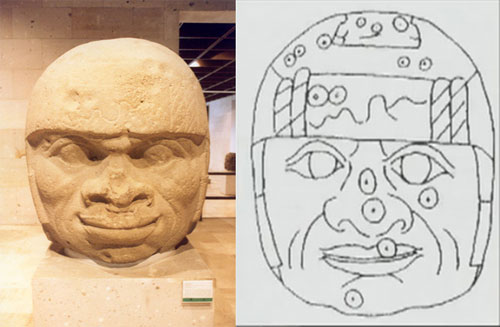
Fig. 3: Left: Dotted depressions on the headdress and the face: San Lorenzo Colossal Head 9. Olmec culture, before 900 BC. Source: www.latinamericanstudies.org (13.2.15). Right: Sketch of Colossal Head 9, highlighting the depressions. Source: Ladron 2009.
Examples of dotted circles in the early Mesoamerican art are the depressions on the Olmec Colossal Heads (fig. 3). They are distributed all over the heads with no apparent pattern. Therefore they riddle the experts: It is unclear whether they have a ritual significance or must be understood as damages through weathering or battles (Casellas Cañellas 2004). However, the fact that all of the depressions show the core-surround principle, and that the heads were found lying on their backs, facing the sky, opens up another possibility: They are gods, priests or divine rulers who see floaters during a visionary trance and thus are connected to the Otherworld or the cosmic essence (see below).
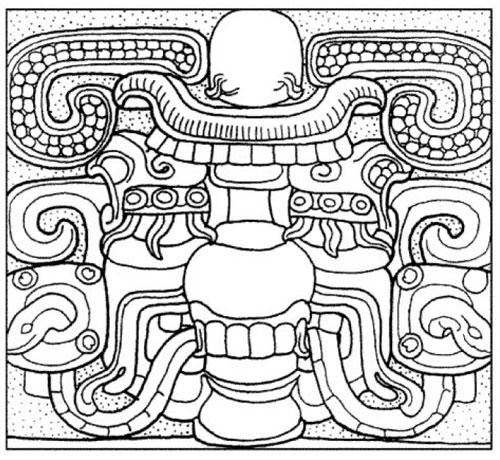
Fig. 4: Personified mountain with snake and maize motifs (above and below), as well as dotted and flame eye lashes. Detail of Tikal pyramid 33 facade (5D-33-2). Maya culture, early 6th century. Source: Schele/Guernsey Kappelman 2001.
The idea of visionary or otherworldly seeing is even more obvious if the concentric circles are shown as eyes or on the eyelids (fig. 4), while rays or flames spread from the eyes, eyebrows or eyelashes. “Flame eyebrows†are frequent among the jaguar-, dragon- or bird-like Olmec deities (Joralemon 1971), i.e. animals, which generally refer to the sky and to shamanic visionary flights (see below). If, however, the circular structures are found around the mouth (fig. 5), another idea is evoked: the transition to the Otherworld. The mouth (of a divine being) is known as a metaphor for the cave and thus for the place of transition to other cosmic spheres. In addition, the circles that are arranged in U-shape and connected by lines or tubes correspond to the frequent Mayan representation of natural pits or cenotes (fig. 6), which also symbolize the passage to the Otherworld.
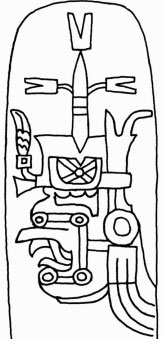
Fig. 5: God II (maize god?) with flame eyebrows and four connected concentric circles arranged around the open mouth. Detail of an engraved Olmec celt of unknown origin. Source: Joralemon 1971.
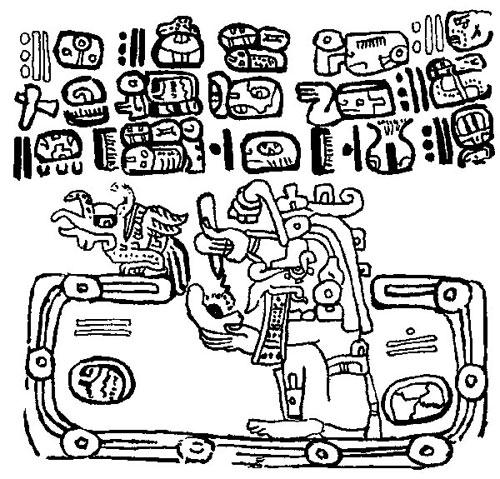
Fig. 6: Rain god Chaak sits within a U-shaped cenote holding a pot of paint and a brush (Vail 2013). Source: Codex Madrid 73.
Also the Maya glyphs for “cave†and “hole†indicate that caves are associated with (seeing) the Otherworld (fig. 7).

Fig. 7: Maya glyphs for “cave†and “holeâ€: 1) ch’en (“cave†or the “impinged eyeâ€); 2) ch’en (“cave†or the “impinged sun/lightâ€); 3) way (“hole,†but also “spirit†and “co-essence†or “nagualâ€); 4) way (“hole†etc.). The latter is a combination of the ajaw glyph (left, “sun god,†which represents half a face with an eye and mouth) and jaguar spots (right). Source: Montgomery 2002.
The flame eye as well as the way glyphs point to a further shamanic aspect of some of the circles in discussion, namely the jaguar. Many Mesoamerican gods and heroes are represented with round spots or circles on their bodies that symbolize the spots on the jaguar skin (fig. 8). These characters thus receive the attributes of the power animal jaguar, i.e. power, dominance, and speed, among others (see Beukers 2013).
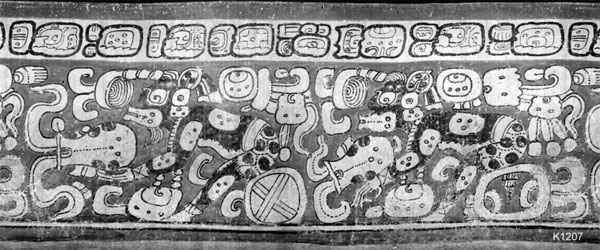
Fig. 8: The hero twins Hunahpú and Xbalanque with jaguar spots on arms, back and legs (see Beukers 2013) pour honey (?) from a vessel. Scene from the Popol Vuh of the Quiché-Maya on a polychrome vase: Source: Justine Kerr, K1207. research.mayavase.com (11.3.15).
In shamanism, the jaguar is considered as a traveler between worlds and is associated with the underworld and the “underworld sun†(Lambert 2013; Stone 2011; Riese 2000; Olivier 1995). Therefore, the jaguar spots may also represent otherworldly visions, especially when they don’t appear realistically, but as stylized circles that are combined with common sky or eye symbols, or arranged in tubes or tracks (fig. 9, 10).
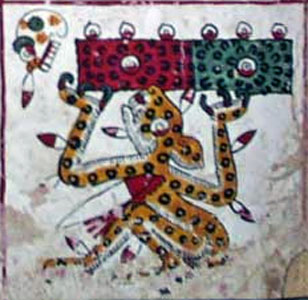
Fig. 9: “Below the night sky, a jaguar is sacrificed: the death of the mighty.†(Anders 1993). The circles on the fur make the jaguar’s limbs appear as channels or tubes. Source: Codex Borgia 24.
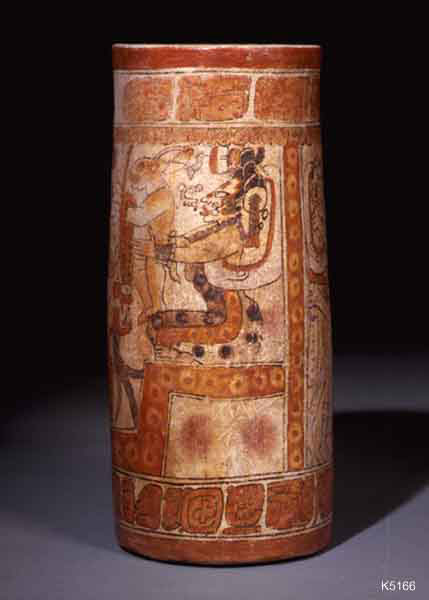
Fig. 10: The moon goddess sits on a throne that is covered with a jaguar skin. The goddess is decorated with circular earspools and jaguar spots. Detail from a Maya polychrome vase. Source: Justin Kerr, K5166. www.mayavase.com (24.3.15).
The same aesthetics and symbolism is seen in the motif of the snake: The “feathered serpent†Kukulcan (Maya) or Quetzalcoatl (Aztec) is a deity and a symbol for the sky and the light, amongst others (Riese 2000; Westphal 1990). The “turquoise serpent†Xiuhcoatl is the spirit form (nagual) of the Aztec fire god Xiuhtecuhtli, leads the sun god Tonatiuh across the sky and, as the fire- or lightning-like weapon of god Huitzilopochtli, ensures the victory of light over darkness in the epic battle on the “Snake Mountain†(Coatépec) (Hassler 2010; Schele/Guernsey Kappelman 2001; Prem 1999). The Maya glyphs kan for “snake†and kaan for “heaven†are symbolically related, based on the same pronunciation (homophone) (Montgomery 2002). And the circular patterns of snake scales generally emblematize lightings or light. This explains why the rain god Chaak is shown with such patterns or in the body of a snake (Kettunen/Helmke 2004; cp. Beukers 2013).
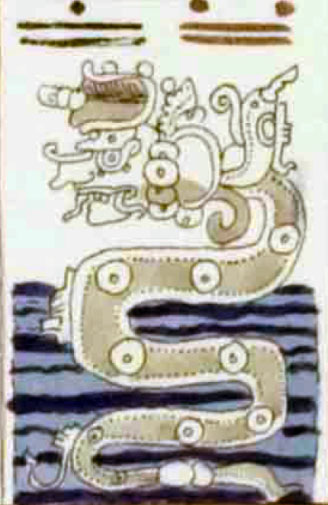
Fig. 11: Maya rain god Chaak as a snake. Source: Codex Dresden 35.
The snake motif not only interrelates the circles with the sky and the light, but also with visionary seeing, insofar as snakes are often the subject of visions (fig. 4, 12) Such “Vision Serpents†can be ascribed to the observation of serpentine light visions during the initial “geometric phase†of ritually induced states of altered consciousness. The Vision Serpents, which can be understood in this context as floater strings filled with dots, develop into more complex figurative scenes in later trance stages. This is why today’s Central and South American shamans regard snakes as the true nature of other animals (Stone 2011; cp. Tausin 2012b; Schele/Guernsey Kappelman 2001; Reilly 1996).
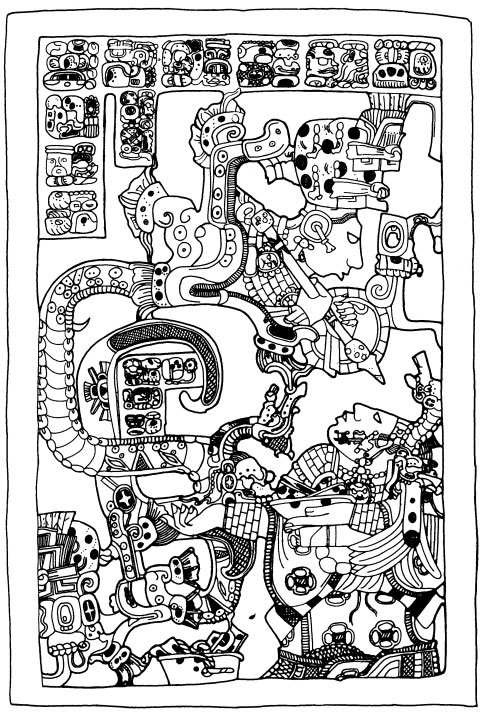
Fig. 12: Lady Xoc, Maya queen consort and wife of Yaxchilán ruler Shield Jaguar II, invokes the Vision Serpent during a bloodletting ritual (Riese 2000). Engraved stone from Yaxchilán (Chiapas, Mexico), c. 700 AD. Source: Pitts 2008. For the original, see: www.pinterest.com (6.2.15).
Finally, the snake as the cosmic or celestial umbilical cord (Guernsey Kappelman 2001; Looper 2001) is one of several metaphors for the shamanic idea of the world axis. In Mesoamerican art, this axis in the center of the world, which connects all cosmic spheres, is often depicted as a cosmic tree (fig. 13, 14, 18) or as a ladder (fig. 15). Many of these representations evoke the vision of a floater network, consisting of tubes and concentric circles.
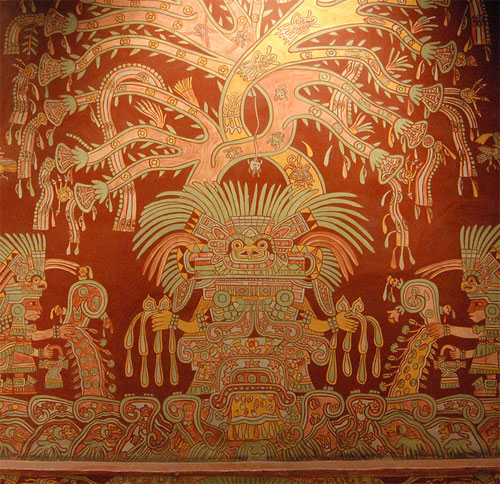
Fig. 13: The world tree grows out of the head of the Great Goddess of Teotihuacán. Its branches contain circular “blossoms†(Carod-Artal 2015; Furst 1972). Mural from the Tepantitla compound in Teotihuacán. Source: upload.wikimedia.org (9.3.15).
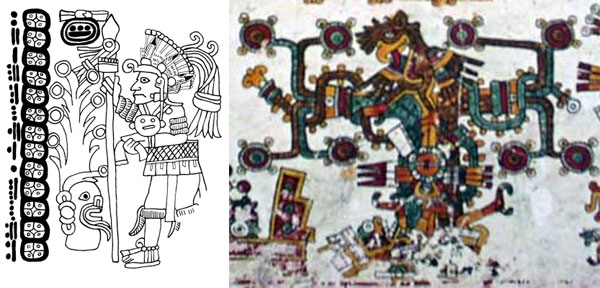
Fig. 14: Cosmic trees with concentric circles as “blossomsâ€. Left: A god is standing before a world tree growing out of the personified “divine†(k’uh) (Vail 2013). Source: Codex Grolier 7. Right: The jade tree grows out of the body of the earth goddess Ciuacoatl (Anders et al. 2013). Source: Codex Borgia 49.
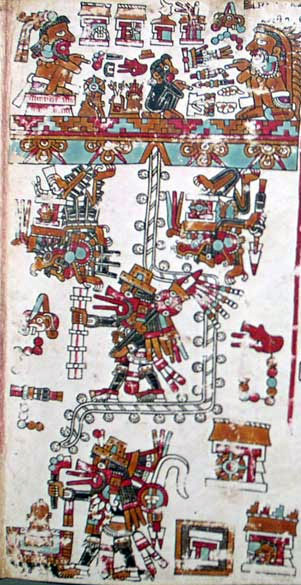
Fig. 15: The heavenly ladder: The Aztec god Quetzalcoatl descends from the sky “on a rope of shells and feathers†(Young 2002). Source: Codex Vindobonensis 48.
Just as the world axis as the cosmic center, the heart as the center of human beings is a means to get in touch with the Otherworld and the gods. In Mesoamerican art we find many scenes of sacrificial rituals where priests or gods open the chests of humans or animals and remove their hearts. This refers to the mythical idea that the gods sacrificed their blood and bodies to create and move and the sun, the stars, the world and the earth, and that it is the task of humans to ensure the gods’ cosmic maintenance by feeding them with sacrificed blood and hearts (Léon-Portilla 2005). It is controversial how frequent and significant human sacrifices really were in the life of the ancient Mesoamericans. There are archaeological clues for heart sacrifices, but some researchers reject that idea. For example, Ancient America scholar Peter Hassler claims that the reports of such practices are propaganda of the Spanish conquerors who needed to justify their raids, enslavement and murders. Instead, the representations of heart sacrifices should be considered as symbolic and mythic actions (Hassler 2010; cp. Westphal 1990; Prem 1999). Fact is that the depicted hearts do not appear naturalistic, but stylized and often as circular or spherical structures (fig. 16, 17, 18).
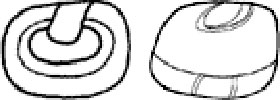
Fig. 16: The Maya glyphs ol for “heart,†“middle†or “centerâ€. Source: Montgomery 2002.
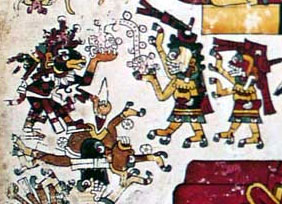
Fig. 17: A priest (Tepeyollotl?) removes the heart of a “light creature†and gives it to two death goddesses (cp. Gerritse 2013). Source: Codex Borgia 34.

Fig. 18: Goddess Xochiquetzal (middle) is nourished by a stream of blood. A tree of jade sprouts from her concentric circular heart (cp. Gerritse 2013). Source: Codex Borgia 44.
At the same time, the heart is a divine and cosmic entity. The Mayan book Popol Vuh mentions the “Heart of Heaven†– a name for one or three sky and lightning gods who created the world (Bassie 2002). Since the first four men “saw all around them†and “examined the four corners, the four points of the arch of the sky and the round face of the earth,†they were equal to the gods. But the gods disliked this, so the Heart of Heaven blew mist into their eyes, which clouded their sight. “Their eyes were covered and they could see only what was close, only that was clear to them. In this way the wisdom and all the knowledge of the four men, the origin and beginning [of the Quiché race], were destroyed.†(Popol Vuh III, 2, quoted after Goetz/Morley 1954). Thus, humans lost their ability to see the divine celestial bodies such as the Heart of Heaven. It is possible, though, that they regain that visionary sight when experiencing ritually altered consciousness states. In Mesoamerican art, many representations of celestial bodies, which are understood as sun, moon and other stars (fig. 19, 20, 21, 22), appear as dotted or concentric circular structures and therefore could point to their mythical and visionary, rather than their mundane aspect.

Fig. 19: Maya glyphs representing celestial bodies. From left: 1. kin (“day,†“sunâ€); 2. kin; 3. ja (“moonâ€); 4. ja; 5. ek‘ (“star,†“Venusâ€). Source: Montgomery 2002.
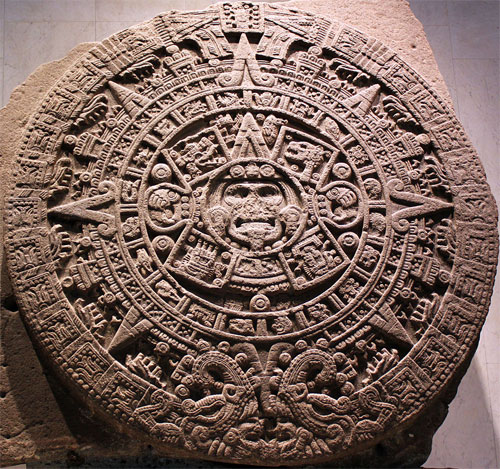
Fig. 20: The Aztec Sun Stone with sun god Tonatiuh in the center, surrounded by several concentric layers of day signs and jewel symbols. Source: upload.wikimedia.org (9.4.15).
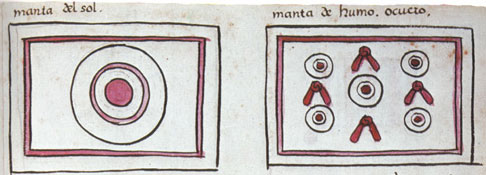
Fig. 21: Aztec sun symbols: The sun (left) and the “occult smoke†(right). Source: Kodex Magliabechiano 17.
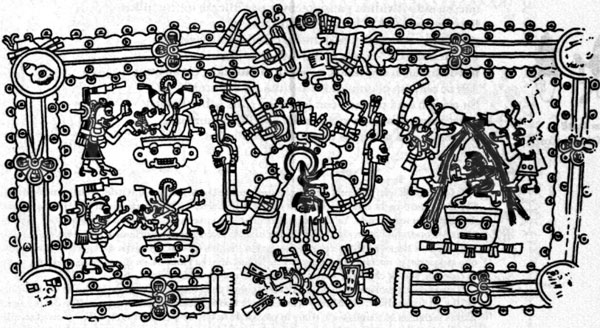
Fig. 22: The night sky covered with stars encloses a scene (Anders et al. 1993). Source: Codex Borgia 31.
So could these celestial bodies be the mythic Heart of Heaven? In the Popol Vuh, the Heart of Heaven is associated with a flash of lightning (Bassie 2002). And the Chilam Balam of Chumayel, another collection of Maya texts, describes the “heart of God the Father†– probably a Christianized version of the Heart of Heaven – as the thirteen celestial layers wrapped up in a “coarse white fabric,†furthermore as a “bead of precious stone,†and finally as a “enormous tortilla,†for there are “thirteen layers of beans†in it (Roys 1933). In short, the Heart of Heaven is round, bright or luminous, and multilayered – which applies to the concentric structures of the represented hearts and celestial bodies, and to the floater spheres alike.
The Heart of Heaven symbolism points to another complex of visionary metaphors, which are represented as scattered or lined-up concentric circles, and which generally signify “valuable substancesâ€. These include Jade or precious stones and maize, as well as blood and flowers or blossoms.

Fig. 23: Maya glyphs for precious stone, maize, blood and flower: 1) pet (“jewelâ€); 2) the day sign imix (fist day in the Tzolk’in calendar), widely associated with maize; 3) water group prefix k’uh (“godly,†“divine,†incorporates an analogy between blood and the soul); 4) water group prefix ch’a (“drop,†e.g. of blood); 5) nikte’ (“flowerâ€). Sources: Stross 2006; Kettunen/Helmke 2005; Montgomery 2002; Taube 1985.
Precious stones, pearls and jade are often found in the headdress and the earspools or ear plugs of gods (fig. 5, 6, 11, 26, 27).They also freely accompany, or are attached to, objects and characters that are “valuable†in a mythic or spiritual sense (fig. 14, 15, 17, 18, 22, 24). The strings of precious stones are sometimes seen as the umbilical cord (Gerritse 2013; Ladron 2009; Anders 1993) and therefore again serves as a link to the cosmic umbilical cord or world axis.
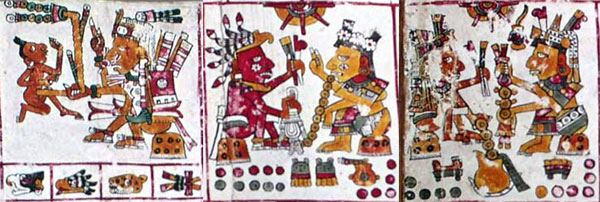
Fig. 24: Examples for “valuable substances†from the ritual calendar of Codex Borgia. Left: A god tears out the umbilical cord of a man; the cord is “precious†because decorated with strings of precious stones. Middle: A string of jade beads flows out of the woman’s mouth, i.e. “valuable wordsâ€. Right: A man and a woman sit on jaguar thrones and hold bloodletting tools. The man fills a pot with a string of beads, i.e. his blood (?). Source: Anders et al. 1993; Codex Borgia 15, 59, 60.
Maize was not only a staple food, but – like the precious stones – a catalyst for the development of Mesoamerican civilization. It was revered as a divine gift or deity and used as an offering in rituals as well as a means to foretell future events (Staller 2010; Léon-Portilla 2005; Westphal 1990). The Olmec and the Maya used the maize grain as an attribute for several deities, often depicted as a dotted circle, sometimes with added “feathers,†and placed at eye or forehead level (Joralemon 1971; Vail 2013 about Codex Madrid 11). These characteristics put the maize grain close to the celestial shamanic floater spheres (fig. 25). Like the precious stones, maize is linked to the world axis: According to the Popol Vuh, the “white†and “yellow†maize kernels, from which the first men were created, was kept in a mountain or the world pillar T’ithach. The rain god opened up the pillar with a blast of lightning, making maize available to the people (Stross 2006; see also the kernels of maize spilled forth from the top of the mountain on fig. 4).

Fig. 25: Olmec maize god with a “feathered maize grain†in front of the forehead. Engraved celt from La Venta, Mexico. Source: Joralemon 1971.
Furthermore, as a valuable material or substance, precious stones and maize can be a metaphor for blood. This is clearly seen in some Mayan rites of self-sacrifice, birth and fertility: The umbilical cord of a newborn is traditionally cut over a corn cob, and the bloodied seeds were saved for the planting. And the so-called water group prefixes (fig. 23) can denote jewels, blood drops, or maize kernels (Taube 1985). These prefixes are used to bestow the “godly†or “holy†attribute (k’uh) on an object or character. Thus, drops or chains of precious stones, maize or blood are metaphors of the sacred. It is not surprising then that the depiction of the breath soul k’ulel – conceptually related to k’uh – is likewise expressed by a metaphor, which takes the form of the concentric circle, namely the flower. According to the Mesoamerican belief, humans have two souls: the “wild animal soul†that dies with the body and is associated with the night, the underworld, the forest and the dreams; and the breath soul that is located in the human blood and the heart and belongs to the everyday world of though and behavior, enters the flower paradise after the death of the body – a celestial mountain or garden where the gods and the ancestors live – and, from there, ascends into the realm of the sun. Thus, the concentric circles as flower or breath soul designate the breath wind or life-giving soul essence – the essence of gods and spirits – of characters, objects or places (fig. 26, 27; Taube 2004).

Fig. 26: A Maya warrior figure with floating concentric circles (flowers?) atop of the Flower Mountain. Detail of a carved pilaster from the Mercado at Chichén Itzá. Source: Taube 2004.
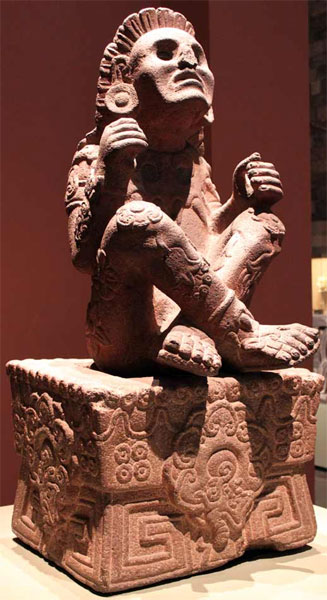
Fig. 27: Aztec flower prince Xochipilli with flower ornaments on earspools, knees, legs and the pedestal (cp. Taube 2004). Source: upload.wikimedia.org (7.4.15)
Again, there is a relationship between the flowery breath soul and shamanic visionary themes: For example, Itzamná, the Mayan god of creation, of the sky, the night and the day, characteristically wears the Akbal flower headdress (fig. 28; cp. Beukers 2013; Bassie 2002). The name Itzamná means “one who does itzâ€. Itz refers to dropping liquids like nectar, but it is also related to the concept of the soul and designates spiritual or shamanic “essence,†“knowledge†or “powerâ€.The term itzam is used for shamans who have the power to manipulate the itz, or cosmic substance of the Otherworld and, therefore, have access to that supernatural world (Montgomery 2002; Guernsey Kappelman 2001). Itzamná’s flowery headdress integrates the notions of the “white flower,†which is breath, and which in turn is the cosmic substance or essence, and the “white flower cords,†a Maya term for the “cosmic umbilicus,†through which the gods descended from the sky and were continually reborn into the world (Looper 2001), and which again refers to the world axis or heavenly ladder (see fig. 15). Therefore, flower cords in Mesoamerican art point to the floater strings that are ritually evoked and looked at by shamans in order to access the Otherworld.
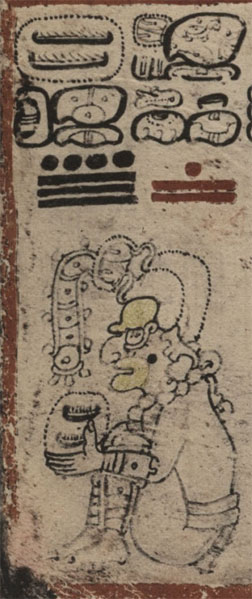
Fig. 28: Maya creator and sky god Itzamná wearing the Akbal flower headdress. Source: Codex Dresden 7.
Shining structure floaters as sacred and luminous essence
The art of pre-Columbian Mesoamerican cultures is rich in abstract geometric signs. This includes the dotted or concentric circles that appear as patterns, ornaments, jewelry or other attributes of deities, humans, animals, objects and places. In this article, I have proposed an entoptic interpretation of these circular figures: They are shining structure floaters that were seen by Mesoamerican shamans and seers during ritually induced altered states of consciousness; these shamans have recognized them as meaningful and integrated them in the art and symbolism of their respective cultures. This interpretation is supported, first, by the common form, i.e. the dotted or concentric circle that appears in isolation or combined into loose groups or into strings; second, by the significance of techniques of altered consciousness in Mesoamerican religious life, which increases the probability of observing and interpreting entoptic phenomena; and third, by the shamanic visionary and mythic body of ideas, into which the circular figures are embedded. While some of the circles are evidently connected to visionary seeing, others refer to shamanic notions such as the passage into the Otherworld, the world axis, the soul or the cosmic essence by way of the widely intertwined metaphors cave, jaguar, snake, navel or umbilical cord, heart, celestial body, precious stone, maize, blood and flower. It is therefore conceivable that, during the interaction of abstract and figurative phases of the visionary trip, floaters appeared to the shamans and seers as vision animals, precious stones, maize, flowers etc. Or they were described after the visionary experience with these metaphors, for they not only express their form, but also their nature and meaning. In any case, seeing and moving floaters was something sacred: one was dealing with the luminous spiritual or cosmic essence and, therefore, accessing the Otherworld.
References
The pictures are taken from image hosting websites, from scientific publications (online and print) and/or from my own collection (FT). Either they are licensed under a Creative Commons license, or their copyright is expired, or they are used according to the copyright law doctrine of ‘Zitatrecht,’ ‘fair dealing’ or ‘fair use.’
Bassie, Karen (2002): Maya Creator Gods. www.mesoweb.com (24.3.15)
Beukers, Laura (2013): The Maya Ceramic Book of Creation (MA Thesis, Faculty of Archaeology, University of Leiden). Leiden: openaccess.leidenuniv.nl (5.2.15)
Caretta, M Nicolás; Lelgemann, Achim (2012): “Cross Circles. A case of Northern Mexicoâ€. Adoranten: 60-68. www.rockartscandinavia.com (10.3.15)
Carod-Artal, Francisco Javier. (2015): Hallucinogenic drugs in pre-Colmbian Mesoamerican cultures. In: NeurologÃa 30, no. 1. www.elsevier.es (9.3.15)
Casellas Cañellas, Eliabeth (2004): El Contexto Arqueológico de la Cabeza Colosal Olmeca Número 7 de San Lorenzo, Veracruz, México (Tesis Doctoral, Universitat Autónoma de Barcelona, Facultat de Lletres Departament de Prehistoria. www.tdx.cat (13.2.15)
Coe, Michael D.; Flannery, Kent V. (1967): Early Cultures and Human Ecology in South Coastal Guatemala. Washington: Smithsonian Press
Del Carmen RodrÃguez MartÃnez, MarÃa et al. (2006): “Oldest Writing in the New Worldâ€. In: Science 313, no. 5793: 1610-1614
DeLand Pohl, Mary; Von Nagy, Christopher (2008): The Olmec and Their Contemporaries. In: Encyclopedia of Archaeology, 3 vols., ed. by Deborah M. Pearsall. Academic Press: 217-230
Dowson, T. A.; Lewis-Williams, J. D. (1988). “The Signs of All Timesâ€. Current Anthropology 29, no. 2: 201-245
Ermel, Gisela (2008): Vom Werjaguar zum Regengott. Auf den Spuren eines rätselhaften Darstellungsmotives (Blotspot.ch: Rätsel der Vergangenheit: Mittelamerika). ermel-mittelamerika.blogspot.ch (24.2.15)
Furst, Peter T. (2004): Visionary Plants and Ecstatic Shamanism. In: Expedition 46, no. 1. www.penn.museum (9.3.15)
Furst, Peter (1972): Morning glory and mother goddess at Tepantitla, Teotihuacan: Iconography and Analogy in pre-Columbian art. In: Mesoamerican Archaeology. New Approaches, ed. by Norman Hammond. Austin: University of Texas Press: 187-215
Goetz, Delia; Morley, Sylvanus Griswold (1954): The Book of the People: Popol Vuh (from Adrián Recino’s translation from Quiché into Spanish). Los Angeles: Plantin Press
Gronemeyer, Sven (2003): Bloodletting and Vision quest among the Classic Maya. A medical and iconographic reevaluation. Human Mosaic 34, no. 1-2: 5-14
Guernsey Kappelman, Julia (2001): “Sacred Geography at Izapa and the Performance of Rulershipâ€. In: Landscape and Power in Ancient Mesoamerica, ed. by Rex Koontz, Kathryn Reese-Taylor and Annabeth Headrick. Boulder: Westview Press: 81-111
Harvey, Graham; Wallis, Robert J. (2007): Historical Dictionary of Shamanism (Historical dictionaries of Religions, Philosophies, and Movements, 77). Lanha et al.: The Scarecrow Press, Inc.
Hassler, Peter (2010): “Sie rissen das Herz noch zuckend herausâ€. In: NZZ, 4.12.2010. www.nzz.ch (19.3.15)
Headrick, Annabeth (2001): “Merging Myth and Politics: The Three Temple Complex at Teotihuacanâ€. In: Landscape and Power in Ancient Mesoamerica, ed. by Rex Koontz, Kathryn Reese-Taylor and Annabeth Headrick. Boulder: Westview Press: 169-195
Heyden, Doris et al. (2005): “Mesoamerican Religions: Mythic Themesâ€. In: Encyclopedia of Religion, ed. by Mircea Eliade (first ed. 1987). Macmillan Reference: 5933-5939
Joralemon, David (1974): Ritual Blood-Sacrifice among the Ancient Maya: Part I. Primera Mesa Redonda de Palenque, vol. 2, ed. by Merle G. Robertson. Pebble Beach, Calif: Robert Louis Stevenson School: 59-75
Joralemon, Peter David (1971): A Study of Olmec Iconography (Studies in Pre-Columbian Art and Archaeology 7). Dumbarton Oaks. www.jstor.org (2.3.15)
Kettunen, Harri; Helmke, Christophe (2005): Introduction to Maya Hieroglyphs. Workshop Handbook. Wayeb & Leiden University. www.mesoweb.com (14.3.15)
Killion, Thomas W.; Urcid, Javier (2001): The Olmec Legacy: Cultural Continuity and Change in Mexico’s Southern Gulf Coast Lowlands. In: Journal of Field Archaeology 28: 3-25. www.latinamericanstudies.org (10.2.5)
Koontz, Rex; Reese-Taylor, Kathryn; Headrick, Annabeth (eds.) (2001): Landscape and Power in Ancient Mesoamerica. Boulder: Westview Press
Krusche, Rolf (1965): Schrift und Buchmalerei der Maya-Indianer. 24 Tafeln aus dem Codex Dresdensis. Insel-Verlag
La Barre, Weston (1970): “Old and New World Narcotics: A Statistical Question and an Ethnological Replyâ€. In: Economic Botany 24: 368-373
Ladron, Sara (2009): Colossal Olmecs. (Concert & Lectures Series des City College of San Francisco's Latin American Studies Department und The Consulate of Mexico), 23.12.2009. www.youtube.com (13.2.15)
Lambert, Arnaud F. (2013): Calendrical glyphs and their use in the Olmec-style cave paintings of Oxtotitlán. In: The Post Hole 29: 8-21. www.theposthole.org (8.4.15)
Léon-Portilla, Miguel (2005): “Mesoamerican Religions: Pre-Columbian Religionsâ€. In: Encyclopedia of Religion, ed. by Mircea Eliade (first ed. 1987). Macmillan Reference: 5875-5895
Looper, Matthew G. (1995): The Three Stones of Maya Creation Mythology at Quiriguá. In: Mexicon 27, no. 2: 24-30
Looper, Matthew G. (2001): Dance Performances at Quiriguá. In: Landscape and Power in Ancient Mesoamerica, ed. by Rex Koontz et al.: Boulder: Westview Press: 113-135
Lorenzi, Rossella (2013): Robot Finds Mysterious Spheres in Ancient Temple. In: news.discovery.com, 29.4.13. news.discovery.com (13.2.15)
Lynch, Patricia Ann (2010): Native American Mythology A to Z. Chelsea House
Medina-Elizalde, MartÃn; Rohling, Eelco J. (2012): Collapse of Classic Maya Civilization Related to Modest Reduction in Precipitation. In: Science 24: 956-959
Montgomery, John (2002): Dictionary of Maya Hieroglyphs. Hippocrene Books. www.famsi.org (8.4.15)
Pitts, Mark (2009): Maya Numbers & The Maya Calendar (A Non-Technical Introduction to Maya Glyphs, Book 2). www.famsi.org (30.3.15)
Pitts, Mark (2008): Writing in Maya Glyphs. Names, Places, and Simple Sentences (A Non-Technical Introduction to Maya Glyphs, Book 1). www.famsi.org (30.3.15)
Prem, Hanns J. (1999): Die Azteken: Geschichte – Kultur - Religion. München: Beck
Rätsch, Christian (2004): Enzyklopädie der psychoaktiven Pflanzen. Botanik, Ethnopharmakologie und Anwendungen. AT Verlag
Reilly, F. Kent III. (1996): The Lazy-S: A Formative Period Iconographic Loan to Maya Hieroglyphic Writing. In: Eighth Palenque Round Table, 1993, ed. by Martha J. Macri und Jan McHargue
Riese, Berthold (2000): Die Maya. Geschichte – Kultur – Religion. München: Beck
Rosenswig, Robert M. (2010): The Beginnings of Mesoamerican Civilization. Inter-Regional Interaction and the Olmec. Cambridge: Cambridge University Press
Roys, Ralph L. (1933): The Book of Chilam Balam of Chumayel. Washington: Carnegie Institution. www.mayaweb.nl (24.3.15)
Schele, Linda; Guernsey Kappelman, Julia (2001): What the Heck’s Coatépec? The Formative Roots of an Enduring Mythology. In: Landscape and Power in Ancient Mesoamerica, ed. by Rex Koontz et al. Boulder: Westview Press: 29-53
Schultes, Richard Evans; Hofmann, Albert; Rätsch, Christian (2001): Plants of the Gods. Their Sacred, Healing, and Hallucinogenic Powers. Rochester: Healing Arts Press
Staller, John E. (2010): Maize Cobs and Cultures: History of Zea mays L. Berlin/Heidelberg: Springer
Stomper, Jeffrey A. (2001): “A Model for Late Classic Community Structure at Copán, Hondurasâ€. In: Landscape and Power in Ancient Mesoamerica, ed. by Rex Koontz et al. Boulder: Westview Press: 197-229
Stross, Brian (2006): Maize in Word and Image in Southeastern Mesoamerica. In: Histories of Maize. Multidisciplinary Approaches to the Prehistory, Linguistics, Biogeography, Domestication, and Evolution of Maize, hrsg. v. John Staller, Robert Tykot und Bruce Benz. Walnut Creek, CA: Left Coast Press: 577-598
Taube, Karl A. (2004): Flower Mountain. Concepts of Life, Beauty and Paradise among the Classic Maya. RES: Anthropology and Aesthetics 45: 69-98.
Taube, Karl (1985): The Classic Maya Maize God: A Reappraisal. In: Fifth Palenque Round Table, 1983, ed. by V.M. Fields. San Francisco: Pre-Columbian Art Research Institute: 171-182
Taube, Karl (1998): The Jade Hearth: Centrality, Rulership and the Classic Maya Temple. In: Function and Meaning in Classic Maya Architecturen, ed. by Stephen D. Houston. Washington: Dumbarton Oaks: 427-478. www.doaks.org (23.3.15)
Tausin, Floco (2015): Of Sun Disks, World Portals and Medicine Wheels – Floater Structures in the Ancient North American Art. In: Ovi Magazine, 25.3.15. www.ovimagazine.com (17.5.15)
Tausin, Floco (2012a): Eye Floaters (EF) and other subjective visual phenomena. www.eye-floaters.info (30.9.14)
Tausin, Floco (2012b): Lights from the Other World – Floater structures in the visual arts of modern adn present-day shamans. In: New Age Spirituality, May 15, 2012. new-age-spirituality.com (3.12.14)
Tausin, Floco (2012c): From Prehistoric Shamanism to Early Civilizations: Eye Floater Structures in Ancient Egypt. In: International Journal of Healing and Caring (IJHC) 12, no. 2. www.wholistichealingresearch.com (3.12.14)
Tausin, Floco (2012d): Shamash, Ishthar and Igigi – Floater structures in ancient Mesopotamia. In: Ovi Magazine, August 10, 2012. www.ovimagazine.com (3.12.14)
Tausin, Floco (2011): In-depth observations on eye floaters – A challenge to ophthalmology. In: Sensitive Skin (August 2011). sensitiveskinmagazine.com (17.5.15)
Tausin, Floco (2010a): Eye Floaters. Floating spheres and strings in a seer’s view. In: Holistic Vision 2. www.eye-floaters.info (3.12.14)
Tausin, Floco (2010b): Entoptic phenomena as universal trance phenomena. In: Paranormal Underground 3, issue 11. issuu.com/paranormalunderground (3.12.14)
Tausin, Floco (2009): Mouches Volantes. Eye Floaters as Shining Structure of Consciousness, Leuchtstruktur Verlag: Bern
Thurston, Linda (1991): Entoptic Imagery in People and their Art. (MA thesis, faculty of the Gallatin Division, New York University). home.comcast.net (26.7.11)
Urcid, Javier (2005): Zapotec Writing. Knowledge, Power, and Memory in Ancient Oaxaca (Department of Anthropology, Brandeis University). www.famsi.org (13.5.15)
Vail, Gabrielle (2013): The Maya Hieroglyphic Codices. www.mayacodices.org (30.3.15)
Westphal, Wilfried (1990): Die Maya. Volk im Schatten seiner Väter. Gondrom Verlag
Young, Karl (2002): Approaches to Codex Vindobonensis. www.thing.net (8.4.15)
Zeitlin, Robert N. (2008): Early Cultures of Middle America. In: Encyclopedia of Archaeology, 3 vols., ed. by Deborah M. Pearsall. Academic Press: 162-182
Floco Tausin

The name Floco Tausin is a pseudonym. The author received a PhD at the Faculty of the Humanities at the University of Bern, Switzerland. In theory and practice, he is engaged in the research of subjective visual phenomena in connection with altered states of consciousness and the development of consciousness. In 2009, he published the mystical story “Mouches Volantes†about the spiritual dimension of eye floaters.
floco.tausin@eye-floaters.info
The book:
‚Mouches Volantes. Eye Floaters as Shining Structure of Consciousness‘.
(Spiritual Fiction. ISBN: 978-3033003378. Paperback, 15.2 x 22.9 cm / 6 x 9 inches, 368 pages).
Floco Tausin tells the story about his time of learning with spiritual teacher and seer Nestor, taking place in the hilly region of Emmental, Switzerland. The mystic teachings focus on the widely known but underestimated dots and strands floating in our field of vision, known as eye floaters or mouches volantes. Whereas in ophthalmology, floaters are considered a harmless vitreous opacity, the author gradually learns about them to see and reveals the first emergence of the shining structure formed by our consciousness. »Mouches Volantes« explores the topic of eye floaters in a much wider sense than the usual medical explanations. It merges scientific research, esoteric philosophy and practical consciousness development, and observes the spiritual meaning and everyday life implications of these dots and strands.
»Mouches Volantes« – a mystical story about the closest thing in the world.
See also:
Filed in: entoptic phenomena, externally authored

Leave a Reply